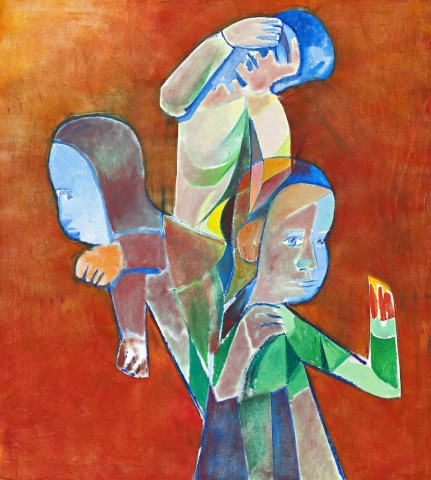THREE GRACES, c.1962
CHARLES BLACKMAN
oil on canvas
152.0 x 135.0 cm
signed lower right: BLACKMAN
Lister Gallery, Perth
Private collection, United Kingdom, acquired from the above c.1994
Following a sell-out exhibition in Brisbane and his win of the Helena Rubenstein travelling scholarship award, Charles Blackman relocated his family to London for an extended stay from January 1961. A further reason for this decision was his inclusion in the high profile exhibition Recent Australian Painting held at the Whitechapel Gallery in June that year. The gallery’s director Bryan Robertson had been highly impressed by Blackman’s work which he’d seen on a research journey to Australia in 1960 and later provided the essay for the artist’s first solo show in London (at the Matthiessen Gallery), proclaiming ‘(t)hese are some of the strongest, most urgent and forceful paintings by a young artist that I have seen in the past ten years’.1 High praise indeed, and Three Graces, c.1962, is a fine example of Blackman’s work from that period.
During their first eighteen months abroad, the Blackmans travelled extensively through France, Switzerland and Italy before renting ‘a large damp basement studio under a health food shop in Archway Road (North London)’.2 Subsequently visiting Amsterdam with Arthur and Yvonne Boyd (who were also now resident in London), the family finally found a more permanent home in Highgate, renting a four-storey Georgian terrace house, where the artist established his studio on the first floor. Described by Barbara Blackman as ‘a proper house, as read about in books, with solid walls, carpets and indoor lavatory – indeed two of them’, it also boasted ‘a view on a clear day to the dome of St Paul’s’.3 The house soon became the epicentre for the large group of expatriates currently living in London – including the Boyd and Perceval families – and they socialised in bars frequented by many of the equally dynamic British artists, such as Peter Blake, Pauline Boty, Robyn Denny, and David Hockney. In spite of the heady atmosphere, ‘Charles was in his studio painting by 6am. His painting discipline was ferocious and his success grew’.4 His graphic skills also developed and increasingly became a defining aspect to his paintings, as seen in the crisp, blue-line delineation of the figures in Three Graces.
The original ‘Graces’ were the daughters of Zeus, symbols of charity in Greek mythology, representing youth, mirth and elegance. Blackman was already renowned for his depictions of the inherent vulnerability and mystery entwined within the lives of young girls and women, and in Three Graces he fuses both the classical past and the 1960s present. Mirroring the nascent Pop-art movement, the girls explode with faceted colour as they twirl within a vivid orange ground. All three avoid direct eye-contact which reinforces the sense of an interior world as if they are individually isolated even as they participate in their mutual dance, one where ‘the precise relationships of warmth, possessiveness, need, or just the being one in a group, as security, are subtly and lyrically defined and made real to us’.5 Following the success of his exhibition at Mathieson Galleries, many more paintings by Blackman entered prominent English and Australian collections. He also attained regal attention, being introduced to Queen Elizabeth II soon after.
1. Robertson, B., ‘Preface’, Paintings and Drawings: Charles Blackman, Matthiessen Gallery, London, 3 – 25 November 1961
2. Moore, F. St. J., Charles Blackman: Schoolgirls and Angels, National Gallery of Victoria, Melbourne, 1993, p. 21
3. Blackman, B., Glass after glass: autobiographical reflections, Viking, Victoria, 1997, p. 231
4. Hawley, J., ‘Charles Blackman’, Artists in Conversation, Slattery Media, Melbourne, 2012, p. 280
5. Shapcott, T., Focus on Charles Blackman, University of Queensland Press, Brisbane, 1967, p. 58
ANDREW GAYNOR
